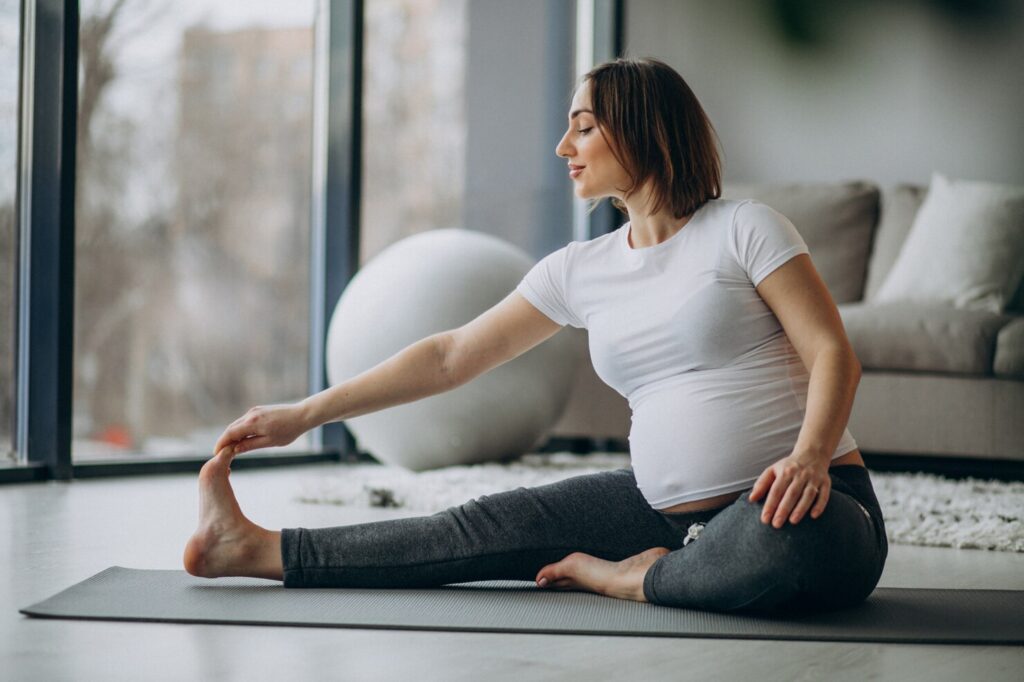- Is it possible to do yoga during pregnancy?
- Yoga for Pregnant Women and Its Psychological Impact
- Perinatal Yoga – Adapting the Practice to the Condition
- Prenatal Yoga: First Trimester
- Prenatal Yoga: Second Trimester
- Prenatal Yoga: Third Trimester
- Prenatal Yoga – How to Prepare at Home?
- Practical Recommendations
Is it possible to do yoga during pregnancy?
It has been proven that prenatal activity for a healthy woman is beneficial for pregnancy. In particular, yoga is one of the gentle and effective methods.
Because regardless of what stage of pregnancy you start practicing, they:
– assist in the intrauterine development of the baby, as the mother’s body balances hormone levels;
– make the mother’s body stronger and more resilient, which helps cope with the strain during pregnancy;
– “teach” the body to handle stress and prepare for the birthing process itself, as yoga involves a comprehensive approach.
As you can see, yoga for pregnant women addresses all the health needs during pregnancy. That’s why in our online sessions at “MomsLab” we provide clear explanations on how to perform exercises during each trimester of pregnancy.

Yoga for Pregnant Women and Its Psychological Impact
For an expectant mother, one of the most crucial factors is psychological peace. The concerns can be quite varied:
– fear of complications during pregnancy;
– anxiety about the process and outcome of childbirth;
– worry about one’s skills as a mother in caring for the baby afterward.
Every second, informational noise presses harder on a woman, and it’s difficult to make sense of the flow of information. Therefore, the main advantage of yoga is teaching mindfulness.
Breathing exercises especially help with this. They not only train proper breathing techniques for childbirth but also bring noticeable benefits to the body long before that.
The ability to gather oneself, avoid panic, and distinguish imaginary fears from real threats can be achieved through both physical and psychological practices. Prenatal yoga helps to accumulate psychological energy and stabilize the functioning of internal organs.

Perinatal Yoga – Adapting the Practice to the Condition
First, it is essential to consult a doctor. This is necessary to discover any possible contraindications and adapt the practice to health indicators. Secondly, it is important to carefully listen to the trainer’s instructions on performing asanas:
– start with simple poses – because even those that seem easy will still bring invaluable benefits;
– do not hold poses to the maximum, remain in them until a comfortable state to avoid worsening any possible discomfort;
– in the second and third trimesters, minimize performing asanas on the back.
Prenatal Yoga: First Trimester
Upon learning about pregnancy, expectant mothers can focus on learning to relieve tension. This involves practicing breathing exercises as well as consciously tensing and relaxing muscles.
Workouts should include poses that:
– stimulate blood circulation;
– improve pelvic floor muscle function;
– open the chest and allow free breathing.
At this stage, yoga can help with digestive issues, manage discomfort in the lower abdomen, reduce nausea and headaches. In online classes, we help mothers strengthen their back muscles and prepare them for future strain.
Important! Avoid poses that put strain on the abdomen: twists, compressions, sharp turns, and lying on the stomach.
Prenatal Yoga: Second Trimester
During the second trimester, we pay even more attention to the pelvic floor muscles and hip joint mobility. We reduce the duration and intensity of exercises and predominantly switch to asanas that provide relaxation.
This is the ideal time when nausea has subsided, the body has gradually adapted to the state of pregnancy, but the belly is not yet too large. During this time, avoid the same exercises you refrained from in the first trimester. Be very cautious with pranayama practices – try not to perform breathing exercises with long breath holds.
We choose asanas that:
– additionally enrich the fetus with oxygen;
– allow for the correct breathing technique;
– relieve the first signs of tension in the back and neck;
– can help prevent varicose veins.

Prenatal Yoga: Third Trimester
The third trimester no longer allows us to perform certain poses. Nevertheless, it’s the most crucial time, as it’s the body’s final preparation for childbirth.
Additionally, poses that require lying on your back for extended periods should be avoided, especially if there are concerns about compressing the inferior vena cava.
We avoid asymmetrical poses to prevent or not to worsen possible symphysis pubis dysfunction. Standing poses should definitely be performed with support or by asking for assistance from loved ones.
It’s a good idea to stock up on items that will ease poses or make them more comfortable: yoga bolsters, special blocks, blankets, or simple cushions.
Even simple exercises can help improve sleep during this period by relieving tension in overstrained body parts and strengthening muscles.

Prenatal Yoga – How to Prepare at Home?
Yoga during pregnancy is safe if specific conditions for practice are met. Ensure sufficient air in the room where you practice. Moreover, make sure there is plenty of free space around, and that your feet do not slip on the floor. Use a special yoga mat. Clothes should be made of natural fabrics and moderately loose. This way you won’t get tangled, and you won’t feel constricted.
Practical Recommendations
Practice is only half the success in preparing for childbirth. For example, in our online program, we combine exercises with:
1) breathing techniques;
2) meditative practices;
as well as with a specially tailored nutrition plan.
In conclusion, remember a few simple rules that will ease the practice:
– get enough sleep;
– train at least two hours after a heavy meal;
– do not endure pain or discomfort while performing exercises;
– lighten the load during asanas by using auxiliary equipment, such as yoga blocks and cushions.



Download the app and get 7 days free use
 eng
eng rus
rus deu
deu spa
spa fra
fra ita
ita por
por srp
srp tur
tur ukr
ukr por
por bos
bos



